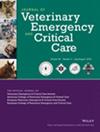Assessment of a standing position during abdominal point-of-care ultrasound on abdominal fluid score in dogs
Abstract
Objective
To assess the use of a standing position during abdominal point-of-care ultrasound (POCUS) examination when evaluating dogs for peritoneal effusion.
Design
Randomized prospective study over 17 months.
Setting
Single-center, university veterinary teaching hospital.
Animals
Thirty dogs presenting for acute abdominal disease. Eligibility included suspicion for free peritoneal effusion and the ability to stand.
Interventions
Dogs underwent standing abdominal POCUS, right lateral abdominal POCUS, and a full abdominal ultrasound. We originally had nothing listed. It now includes all three ultrasound evaluations that were performed for each patient.
Measurements and Main Results
Patients underwent both a right lateral and standing abdominal POCUS via a previously described abdominal focused assessment with sonography for trauma (A-FASTrl and A-FASTs, respectively) technique in a randomized and sequential order followed by a full abdominal ultrasound (AUS-full). The A-FASTs examination included a right flank location in addition to the following standard views: subxiphoid, left flank, urinary bladder, and umbilicus. Five-second cine loops were obtained at each location for each examination and reviewed in the order they were obtained. Locations for both A-FAST exams were interrogated in the same order every time. The cine loops were scored for the degree of peritoneal effusion based on a previously published abdominal fluid scoring system by a board-certified radiologist, radiology resident, and radiology intern. The overall abdominal fluid score (AFS) was compared to a subjective full abdominal ultrasound score given by a board-certified radiologist. Six dogs had no peritoneal effusion, 13 had a small volume (AFS 1 or 2), and 11 had a moderate to large volume (AFS 3 or 4). Excellent agreement (intraclass correlation coefficient) was found between the A-FASTs and A-FASTrl techniques (0.95, 0.93, 0.94), good agreement between A-FASTs and AUS-full (0.80, 0.77, 0.82), and good agreement between A-FASTrl and AUS-full (0.80, 0.82, 0.84). The interobserver agreement was good (0.87) for the A-FASTs technique and excellent (0.91) for the A-FASTrl technique. Mean observer agreement score was excellent (0.94) when evaluating A-FASTrl to A-FASTs, good (0.86) when evaluating A-FASTs to AUS-full, and good (0.87) when evaluating A-FASTrl to AUS-full.
Conclusion
Performing a standing abdominal POCUS examination may be a valid option for identifying and quantifying peritoneal effusion in situations when a more traditional right lateral approach cannot be performed.

 求助内容:
求助内容: 应助结果提醒方式:
应助结果提醒方式:


